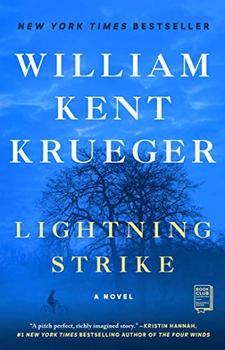Summary | Excerpt | Reading Guide | Reviews | Beyond the Book | Read-Alikes | Genres & Themes | Author Bio

Cork O'Connor Mystery Series #18
by William Kent KruegerThis article relates to Lightning Strike
 In Lightning Strike, William Kent Krueger includes an author's note about the Indian Relocation Act of 1956 (also known as Public Law 959 or the Adult Vocational Training Program), which features as a tragic backdrop to the overall story. According to Krueger, the program was "the brainchild of a group of men appointed by President Harry S. Truman to solve what lawmakers in Washington, D.C., called 'the Indian problem.'" It was a "problem" of the government's own creation — the financial burden of sustaining reservations only existed because Native Americans had been displaced from the land on which they had previously been living.
In Lightning Strike, William Kent Krueger includes an author's note about the Indian Relocation Act of 1956 (also known as Public Law 959 or the Adult Vocational Training Program), which features as a tragic backdrop to the overall story. According to Krueger, the program was "the brainchild of a group of men appointed by President Harry S. Truman to solve what lawmakers in Washington, D.C., called 'the Indian problem.'" It was a "problem" of the government's own creation — the financial burden of sustaining reservations only existed because Native Americans had been displaced from the land on which they had previously been living.
Native Americans struggled mightily (and still do) to keep their communities together on reservations. The 1956 act sought to put an end to Native communities by terminating many reservations and reducing or canceling government services to many others. In "return," the government promised to pay the costs for those Native American families willing to move to urban areas where they could "assimilate" into broader American society. Housing, jobs and vocational training were also promised.
The results of this 20-year campaign to eliminate reservations were disastrous for Native Americans, who still deal with the ripple effects today. According to a recent article for American Public Media Reports:
The goal was to move Native Americans to cities, where they would disappear through assimilation into the white, American mainstream. Then, the government would make tribal land taxable and available for purchase and development. The vision was that eventually there would be no more BIA (Bureau of Indian Affairs), no more tribal governments, no more reservations, and no more Native Americans.
The promises made by the U.S. government to Native Americans once again proved worthless when relocated families found themselves in bad neighborhoods with substandard housing and only seasonal or low-paying jobs (or no jobs at all). Perhaps most jarring for Native people was the alienation and isolation of living in a white, American culture so different from their own. To compound their misery, for those who still had a reservation to return to, the government would not pay to move them back. In essence, they were stranded, having traded rural poverty for urban poverty.
Today, the effects of this legislation to break up Native American communities and end reservation living are evident in the demographics. When the Bureau of Indian affairs began the relocation project, under eight percent of Native Americans lived in cities, whereas in the 2000 census, that number had risen to 64% of the Native population. Many of today's city-dwelling Native Americans still wrestle with racial and job discrimination, low-paying jobs and a sense of cultural dysphoria.
Those who relocated to the cities as a result of the act formed groups in an effort to maintain their cultural identities and provide mutual aid.
According to the National Council of Urban Indian Health, in these urban areas "community leaders ... created environments where our brothers and sisters could feel at home away from their motherlands; where the Native American culture & traditions were understood and appreciated; and health services to our siblings could be rendered." Today, there is a network of 33 Urban Indian Health Programs, along with numerous other non-profit organizations in cities across the country that assist Native Americans living in cities with health and social issues while providing a hub for the maintenance of their traditions and values.
Though the characters uprooted by the Indian Relocation Act of 1956 are fictional in Krueger's Lightning Strike, they represent the thousands of real-life Native American individuals and families who suffered under this thinly veiled eradication plan. It is a sobering reminder that there is some truth to Ronald Reagan's much quoted comment, "The nine most terrifying words in the English language are: I'm from the Government, and I'm here to help."
Promotional material for the Indian Relocation Act of 1956, courtesy of American Public Media
Filed under People, Eras & Events
![]() This "beyond the book article" relates to Lightning Strike. It originally ran in October 2021 and has been updated for the
July 2022 paperback edition.
Go to magazine.
This "beyond the book article" relates to Lightning Strike. It originally ran in October 2021 and has been updated for the
July 2022 paperback edition.
Go to magazine.
Your guide toexceptional books
BookBrowse seeks out and recommends the best in contemporary fiction and nonfiction—books that not only engage and entertain but also deepen our understanding of ourselves and the world around us.